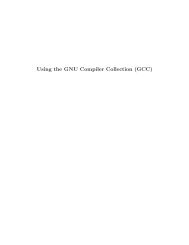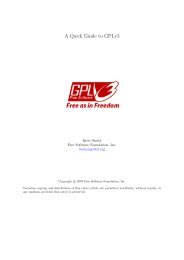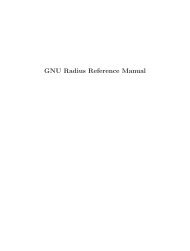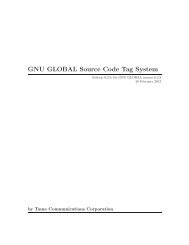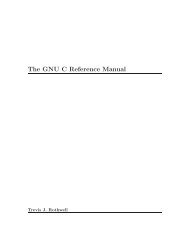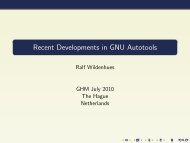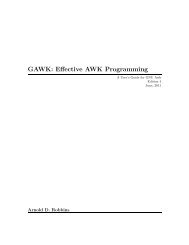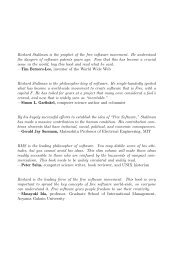by Trent A. Fisher and Werner Lemberg - The GNU Operating System
by Trent A. Fisher and Werner Lemberg - The GNU Operating System
by Trent A. Fisher and Werner Lemberg - The GNU Operating System
You also want an ePaper? Increase the reach of your titles
YUMPU automatically turns print PDFs into web optimized ePapers that Google loves.
20 <strong>The</strong> <strong>GNU</strong> Troff Manual<br />
3.2.2 Sections <strong>and</strong> Chapters<br />
Most macro packages supply some form of section headers. <strong>The</strong> simplest<br />
kind is simply the heading on a line <strong>by</strong> itself in bold type. Others supply<br />
automatically numbered section heading or different heading styles at different<br />
levels. Some, more sophisticated, macro packages supply macros for<br />
starting chapters <strong>and</strong> appendices.<br />
3.2.3 Headers <strong>and</strong> Footers<br />
Every macro package gives some way to manipulate the headers <strong>and</strong> footers<br />
(also called titles) on each page. This is text put at the top <strong>and</strong> bottom of<br />
each page, respectively, which contain data like the current page number,<br />
the current chapter title, <strong>and</strong> so on. Its appearance is not affected <strong>by</strong> the<br />
running text. Some packages allow for different ones on the even <strong>and</strong> odd<br />
pages (for material printed in a book form).<br />
<strong>The</strong> titles are called three-part titles, that is, there is a left-justified<br />
part, a centered part, <strong>and</strong> a right-justified part. An automatically generated<br />
page number may be put in any of these fields with the ‘%’ character<br />
(see Section 5.15 [Page Layout], page 104, for more details).<br />
3.2.4 Page Layout<br />
Most macro packages let the user specify top <strong>and</strong> bottom margins <strong>and</strong> other<br />
details about the appearance of the printed pages.<br />
3.2.5 Displays<br />
Displays are sections of text to be set off from the body of the paper. Major<br />
quotes, tables, <strong>and</strong> figures are types of displays, as are all the examples used<br />
in this document.<br />
Major quotes are quotes which are several lines long, <strong>and</strong> hence are set<br />
in from the rest of the text without quote marks around them.<br />
A list is an indented, single-spaced, unfilled display. Lists should be used<br />
when the material to be printed should not be filled <strong>and</strong> justified like normal<br />
text, such as columns of figures or the examples used in this paper.<br />
A keep is a display of lines which are kept on a single page if possible.<br />
An example for a keep might be a diagram. Keeps differ from lists in that<br />
lists may be broken over a page boundary whereas keeps are not.<br />
Floating keeps move relative to the text. Hence, they are good for things<br />
which are referred to <strong>by</strong> name, such as “See figure 3”. A floating keep<br />
appears at the bottom of the current page if it fits; otherwise, it appears at<br />
the top of the next page. Meanwhile, the surrounding text ‘flows’ around<br />
the keep, thus leaving no blank areas.<br />
3.2.6 Footnotes <strong>and</strong> Annotations<br />
<strong>The</strong>re are a number of requests to save text for later printing.



